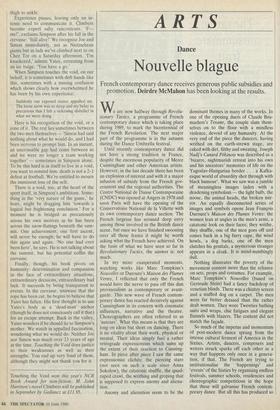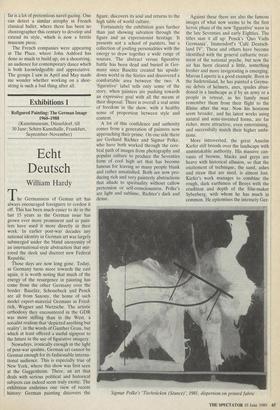ARTS
Dance
Nouvelle blague
French contemporary dance receives generous public subsidies and promotion. Deirdre McMahon has been looking at the results.
We are now halfway through Revolu- tionary Tactics, a programme of French contemporary dance which is taking place during 1989, to mark the bicentennial of the French Revolution. The next major part of the programme is in the autumn during the Dance Umbrella festival.
Until recently contemporary dance did not have a strong tradition in France, despite the enormous popularity of Merce Cunningham and other American artists. However, in the last decade there has been an explosion of interest and with it a major infusion of subsidy from the French gov- ernment and the regional authorities. The Centre National de Danse Contemporaine (CNDC) was opened at Angers in 1978 and soon Paris will have the opening of the Conservatoire National de la Villette with its own contemporary dance section. The French largesse has aroused deep envy among those involved in the British dance scene, but once we have finished swooning over all those francs it might be worth asking what the French have achieved. On the basis of what we have seen so far in Revolutionary Tactics, the answer is: not much.
In my more exasperated moments, watching works like Marc Tompkins's Nouvelles or Duroure's Maison des Plumes Vertes, I reflected that only the French would have the nerve to pass off this dim provincialism as contemporary or avant- garde. This new wave of French contem- porary dance has reacted decisively against Cunningham in its concern with cinematic influences, narrative and the theatre. Choreographers are often referred to as `auteurs'. What this means is that they are long on ideas but short on dancing. There is no vitality about their work, physical or mental. Their ideas simply fuel a rather retrograde expressionism which sums up the extent of their reaction to Cunning- ham. In piece after piece I saw the same expressionist clichés: the piercing stare (not seen on such a scale since Anna Sokolow), the catatonic shuffle, the quad- ruped crawl, the writhing and groping that is supposed to express anomy and aliena- tion.
Anomy and alienation seem to be the dominant themes in many of the works. In one of the opening duets of Claude Bru- machon's Texane, the couple slam them- selves on to the floor with a mindless violence, devoid of any humanity. At the very end of the piece the dancers, having writhed on the earth-strewn stage, are caked with dirt, filthy and sweating. Joseph Nadj's Canard Pekinois was described as a `bizarre, nightmarish retreat into his own and his ancestors' memories of life on the Yugoslav-Hungarian border . . . a Kafka- esque world of absurdity shot through with black humour'. What we saw was a jumble of meaningless images laden with a deadening symbolism — the light bulb, the noose, the animal heads, the broken mir- ror. An equally disconnected series of images and symbols opens Jean Francois Duroure's Mason des Plumes Vertes: the women lean at angles in the men's arms, a catatonic look on their faces; they writhe, they shuffle, one of the men goes off and comes back in a big furry cape, the wind howls, a dog barks, one of the men clutches his genitals, a mysterious stranger appears in a cloak. It is mind-numbingly dull.
Nothing illustrates the poverty of the movement content more than the reliance on sets, props and costumes. For example, Marc Tompkins's Nouvelles (based on Gertrude Stein) had a fancy backdrop of venetian blinds. There was a chintzy screen and a stuffed dog on a carpet. The men were far better dressed than the rather drab women. They wore Twenties bathing suits and wraps, chic fatigues and elegant flannels with blazers. The content did not match the facade.
So much of the impetus and momentum of post-modern dance sprang from the intense cultural ferment of America in the Sixties. Artists, dancers, composers and writers struck sparks off each other in a way that happens only once in a genera- tion, if that. The French are trying to institutionalise the 'happenings' and `events' of the Sixties by organising endless festivals, summer schools, residencies and choreographic competitions in the hope that these will galvanise French contem- porary dance. But all this has produced so far is a lot of pretentious navel-gazing. One can detect a similar atrophy in French classical ballet, where there has been no choreographer this century to develdp and extend its style, which is now a brittle museum piece.
The French companies were appearing at The Place, where John Ashford has done so much to build up, on a shoestring, an audience for contemporary dance which is both knowledgeable and appreciative. The groups I saw in April and May made me wonder whether working on a shoe- string is such a bad thing after all.



























































 Previous page
Previous page